2005 AUDI A6 sensor
[x] Cancel search: sensorPage 53 of 92
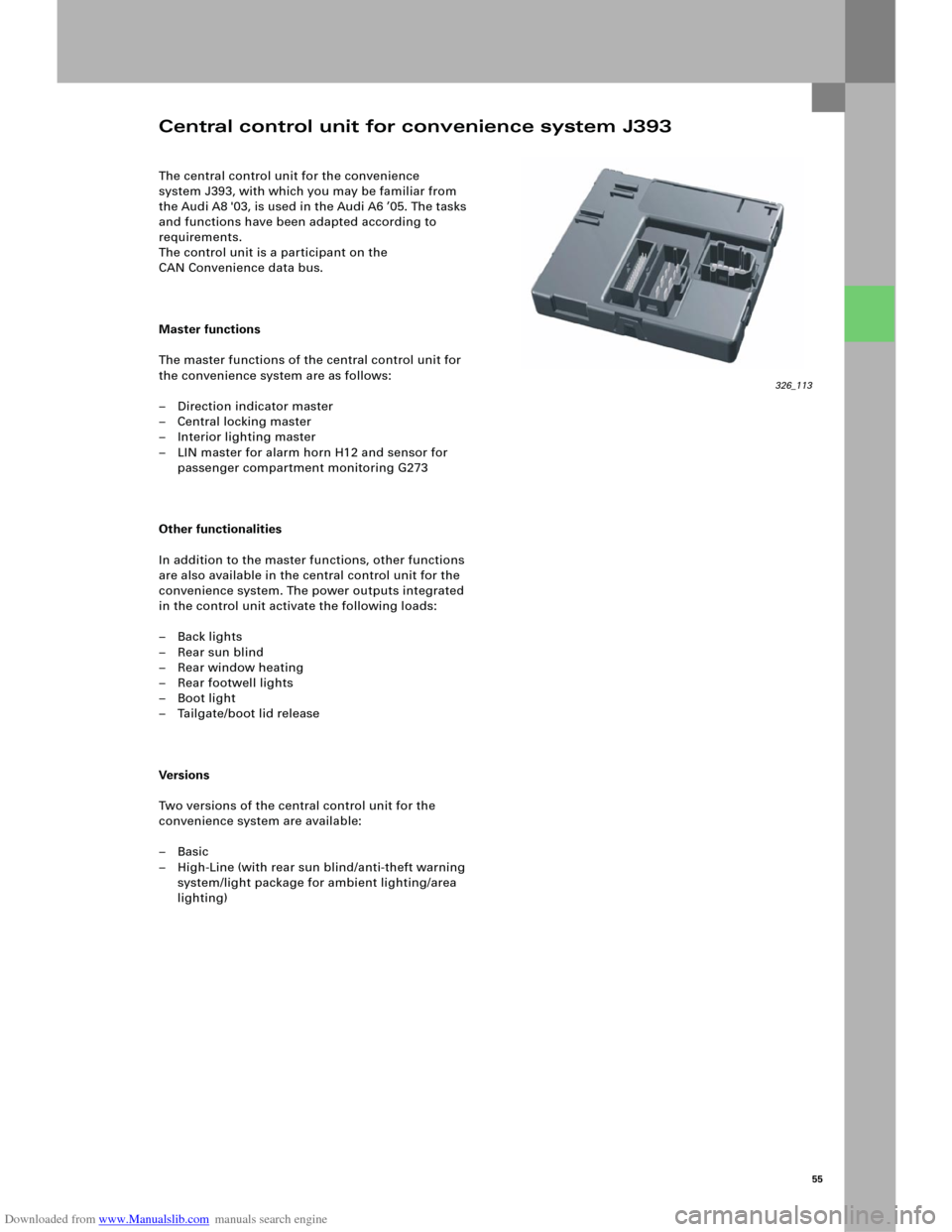
Downloaded from www.Manualslib.com manuals search engine 55
The central control unit for the convenience
system J393, with which you may be familiar from
the Audi A8 '03, is used in the Audi A6 ’05. The tasks
and functions have been adapted according to
requirements.
The control unit is a participant on the
CAN Convenience data bus.
Master functions
The master functions of the central control unit for
the convenience system are as follows:
– Direction indicator master
– Central locking master
– Interior lighting master
– LIN master for alarm horn H12 and sensor for
passenger compartment monitoring G273
Other functionalities
In addition to the master functions, other functions
are also available in the central control unit for the
convenience system. The power outputs integrated
in the control unit activate the following loads:
– Back lights
–Rear sun blind
– Rear window heating
– Rear footwell lights
–Boot light
– Tailgate/boot lid release
Ve rs i on s
Two versions of the central control unit for the
convenience system are available:
–Basic
– High-Line (with rear sun blind/anti-theft warning
system/light package for ambient lighting/area
lighting)
Central control unit for convenience system J393
326_113
Page 54 of 92
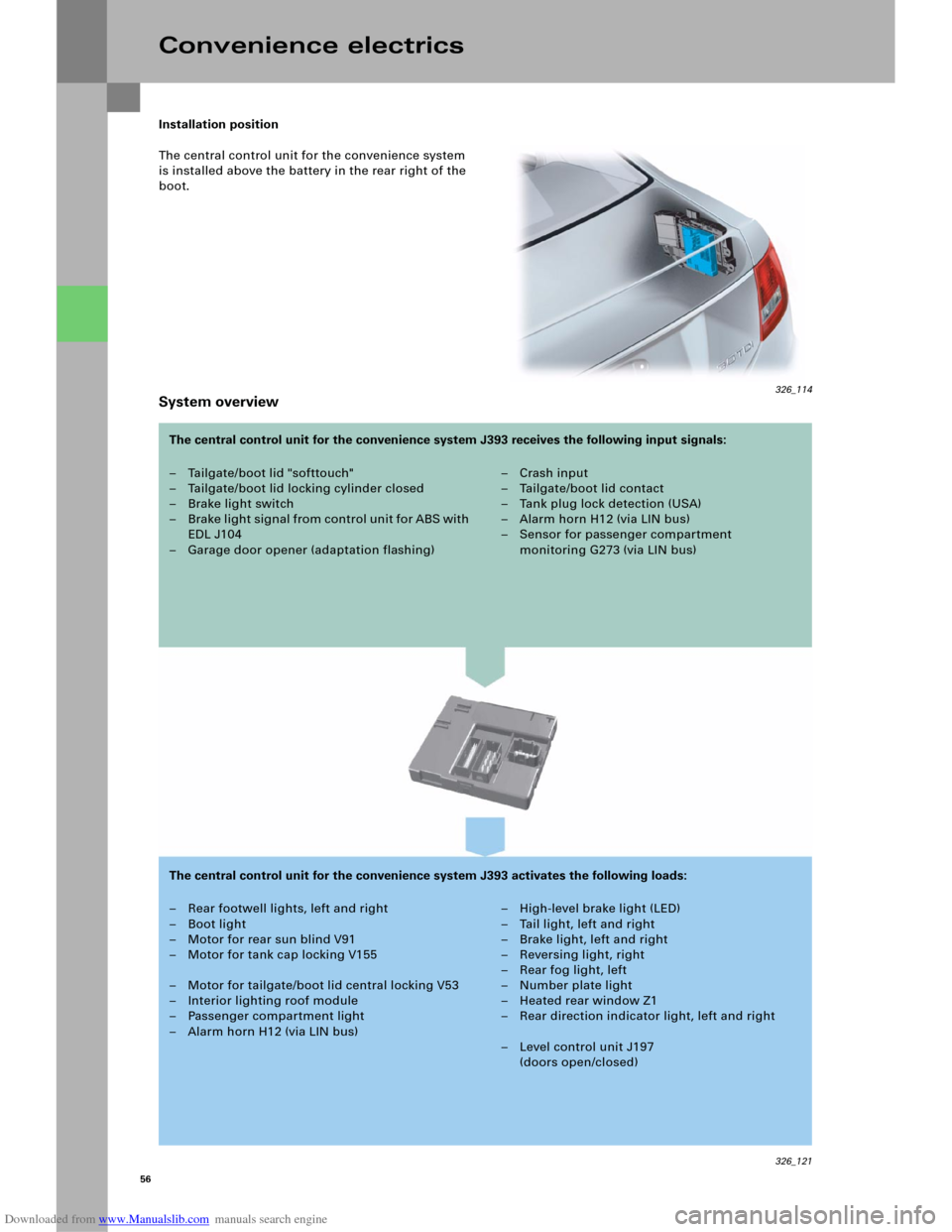
Downloaded from www.Manualslib.com manuals search engine 56
326_121
Installation position
The central control unit for the convenience system
is installed above the battery in the rear right of the
boot.
System overview
Convenience electrics
– Tailgate/boot lid "softtouch"
– Tailgate/boot lid locking cylinder closed
– Brake light switch
– B rake li ght signal from control u ni t fo r ABS with
EDL J104
– Garage door opener (adaptation flashing)– Crash input
– Tailgate/boot lid contact
–Tank plug lock detection (USA)
– Alarm horn H12 (via LIN bus)
– Sensor for passenger compartment
monitoring G273 (via LIN bus)
– Rear footwell lights, left and right
– Boot light
– Motor for rear sun blind V91
– Motor for tank cap locking V155
– Motor for tailgate/boot lid central locking V53
– Interior lighting roof module
– Passenger compartment light
– Alarm horn H12 (via LIN bus)– High-level brake light (LED)
– Tail light, left and right
–Brake light, left and right
– Reversing light, right
–Rear fog light, left
– Number plate light
– Heated rear window Z1
– Rear direction indicator light, left and right
– Level control unit J197
(doors open/closed) The central control unit for the convenience system J393 receives the following input signals:
The central control unit for the convenience system J393 activates the following loads:
326_114
Page 56 of 92
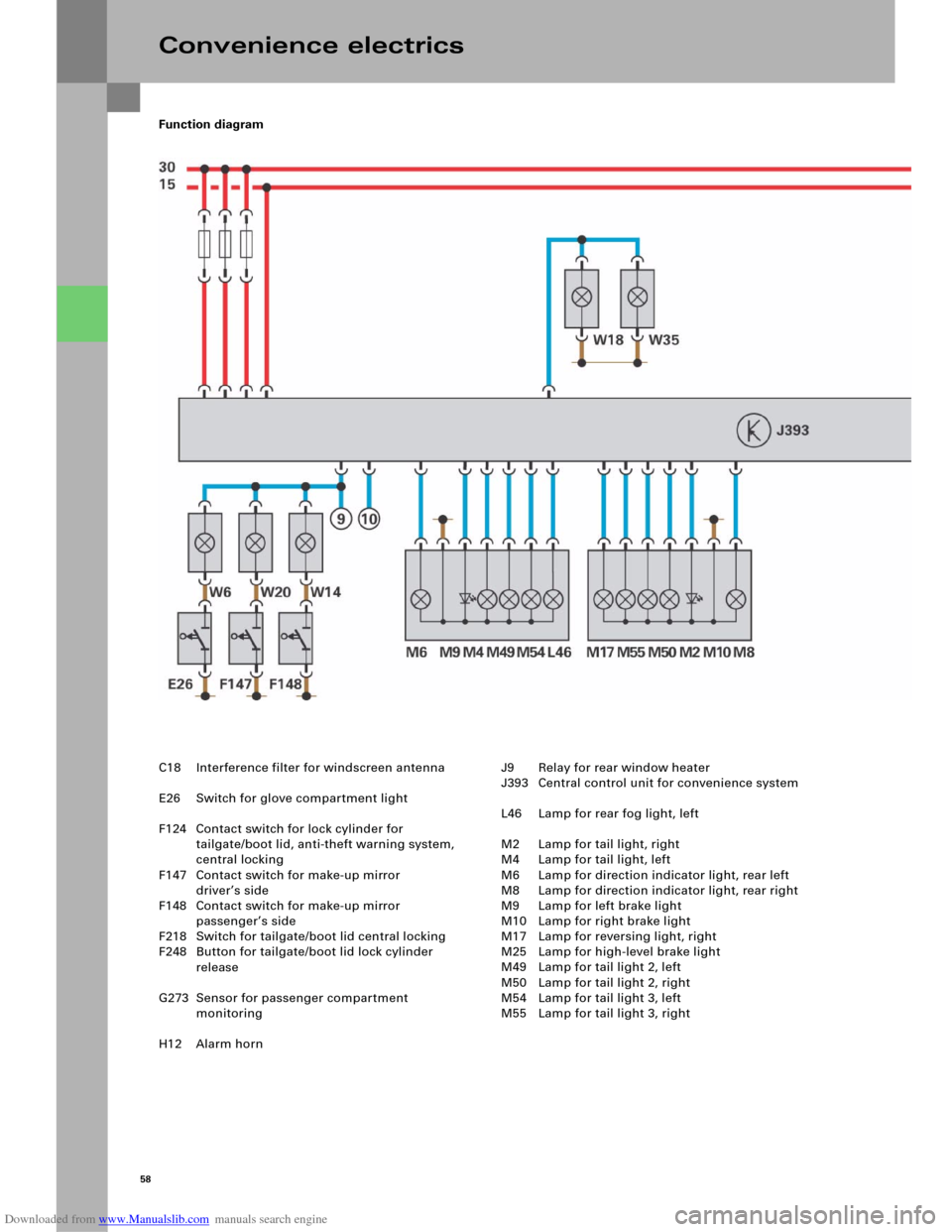
Downloaded from www.Manualslib.com manuals search engine 58
Function diagram
Convenience electrics
C18 Interference filter for windscreen antenna
E26 Switch for glove compartment light
F124 Contact switch for lock cylinder for
tailgate/boot lid, anti-theft warning system,
central locking
F147 Contact switch for make-up mirror
driver’s side
F148 Contact switch for make-up mirror
passenger’s side
F218 Switch for tailgate/boot lid central locking
F248 Button for tailgate/boot lid lock cylinder
release
G273 Sensor for passenger compartment
monitoring
H12 Alarm hornJ9 Relay for rear window heater
J393 Central control unit for convenience system
L46 Lamp for rear fog light, left
M2 Lamp for tail light, right
M4 Lamp for tail light, left
M6 Lamp for direction indicator light, rear left
M8 Lamp for direction indicator light, rear right
M9 Lamp for left brake light
M10 Lamp for right brake light
M17 Lamp for reversing light, right
M25 Lamp for high-level brake light
M49 Lamp for tail light 2, left
M50 Lamp for tail light 2, right
M54 Lamp for tail light 3, left
M55 Lamp for tail light 3, right
Page 58 of 92
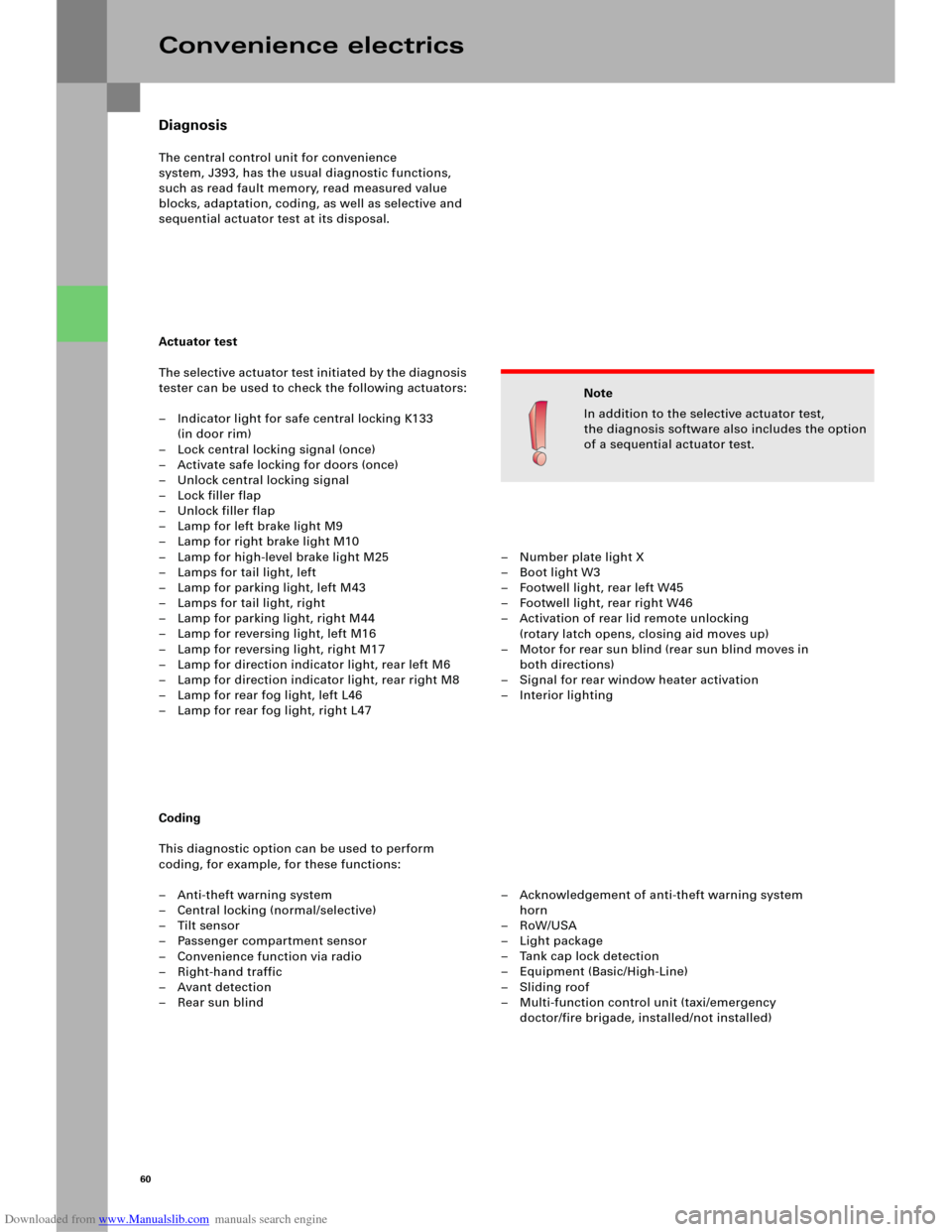
Downloaded from www.Manualslib.com manuals search engine 60
Diagnosis
The central control unit for convenience
system, J393, has the usual diagnostic functions,
such as read fault memory, read measured value
blocks, adaptation, coding, as well as selective and
sequential actuator test at its disposal.
Actuator test
The selective actuator test initiated by the diagnosis
tester can be used to check the following actuators:
– Indicator light for safe central locking K133
(in door rim)
– Lock central locking signal (once)
– Activate safe locking for doors (once)
– Unlock central locking signal
– Lock filler flap
– Unlock filler flap
– Lamp for left brake light M9
– Lamp for right brake light M10
– Lamp for high-level brake light M25
– Lamps for tail light, left
– Lamp for parking light, left M43
– Lamps for tail light, right
– Lamp for parking light, right M44
– Lamp for reversing light, left M16
– Lamp for reversing light, right M17
– Lamp for direction indicator light, rear left M6
– Lamp for direction indicator light, rear right M8
– Lamp for rear fog light, left L46
– Lamp for rear fog light, right L47
Coding
This diagnostic option can be used to perform
coding, for example, for these functions:
– Anti-theft warning system
– Central locking (normal/selective)
–Tilt sensor
– Passenger compartment sensor
– Convenience function via radio
–Right-hand traffic
–Avant detection
–Rear sun blind
Convenience electrics
Note
In addition to the selective actuator test,
the diagnosis software also includes the option
of a sequential actuator test.
– Number plate light X
– Boot light W3
– Footwell light, rear left W45
– Footwell light, rear right W46
– Activation of rear lid remote unlocking
(rotary latch opens, closing aid moves up)
– Motor for rear sun blind (rear sun blind moves in
both directions)
– Signal for rear window heater activation
–Interior lighting
– Acknowledgement of anti-theft warning system
horn
–RoW/USA
–Light package
– Tank cap lock detection
– Equipment (Basic/High-Line)
–Sliding roof
– Multi-function control unit (taxi/emergency
doctor/fire brigade, installed/not installed)
Page 59 of 92
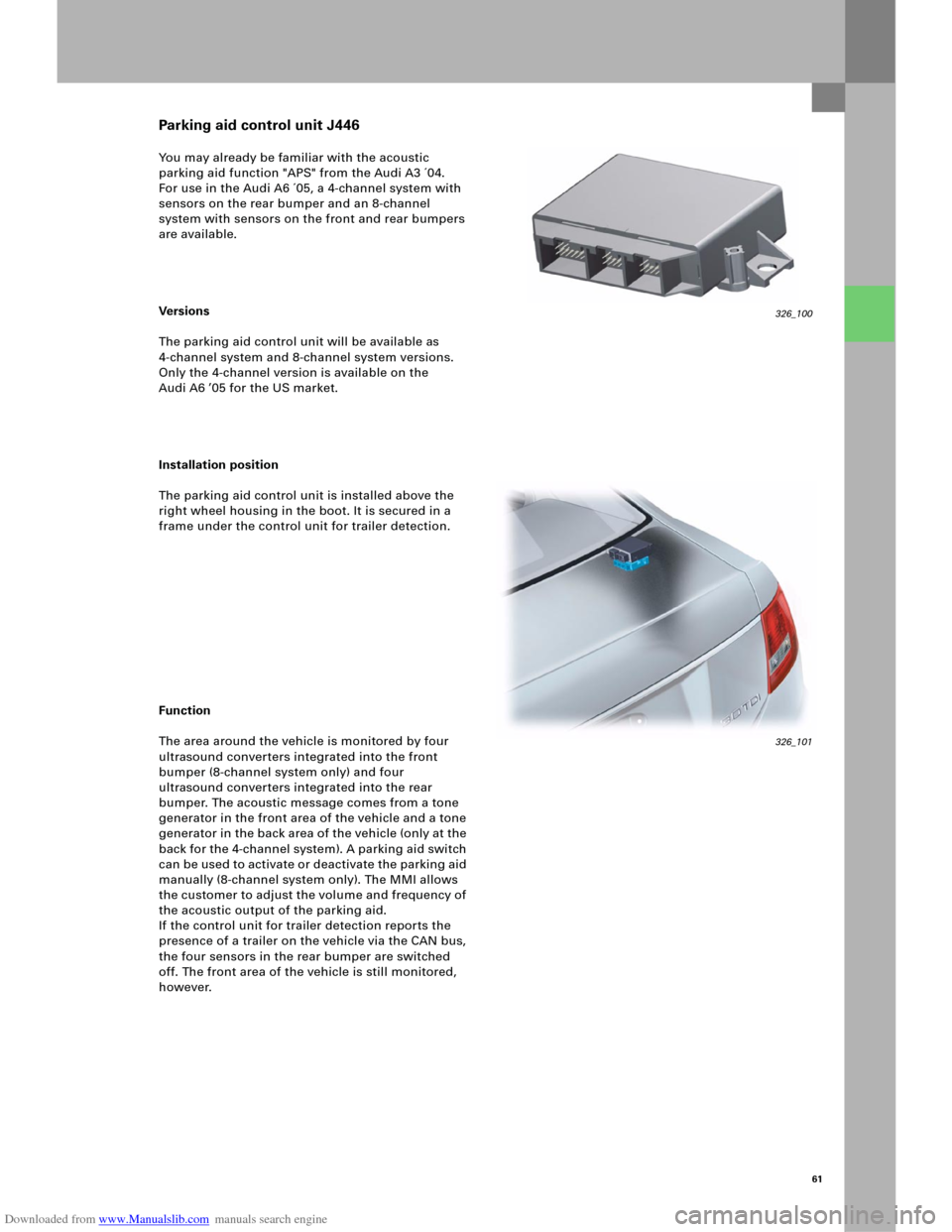
Downloaded from www.Manualslib.com manuals search engine 61
You may already be familiar with the acoustic
parking aid function "APS" from the Audi A3 ´04.
For use in the Audi A6 ´05, a 4-channel system with
sensors on the rear bumper and an 8-channel
system with sensors on the front and rear bumpers
are available.
Ve rs i on s
The parking aid control unit will be available as
4-channel system and 8-channel system versions.
Only the 4-channel version is available on the
Audi A6 ’05 for the US market.
Installation position
The parking aid control unit is installed above the
right wheel housing in the boot. It is secured in a
frame under the control unit for trailer detection.
Function
The area around the vehicle is monitored by four
ultrasound converters integrated into the front
bumper (8-channel system only) and four
ultrasound converters integrated into the rear
bumper. The acoustic message comes from a tone
generator in the front area of the vehicle and a tone
generator in the back area of the vehicle (only at the
back for the 4-channel system). A parking aid switch
can be used to activate or deactivate the parking aid
manually (8-channel system only). The MMI allows
the customer to adjust the volume and frequency of
the acoustic output of the parking aid.
If the control unit for trailer detection reports the
presence of a trailer on the vehicle via the CAN bus,
the four sensors in the rear bumper are switched
off. The front area of the vehicle is still monitored,
however.
326_100
Parking aid control unit J446
326_101
Page 62 of 92
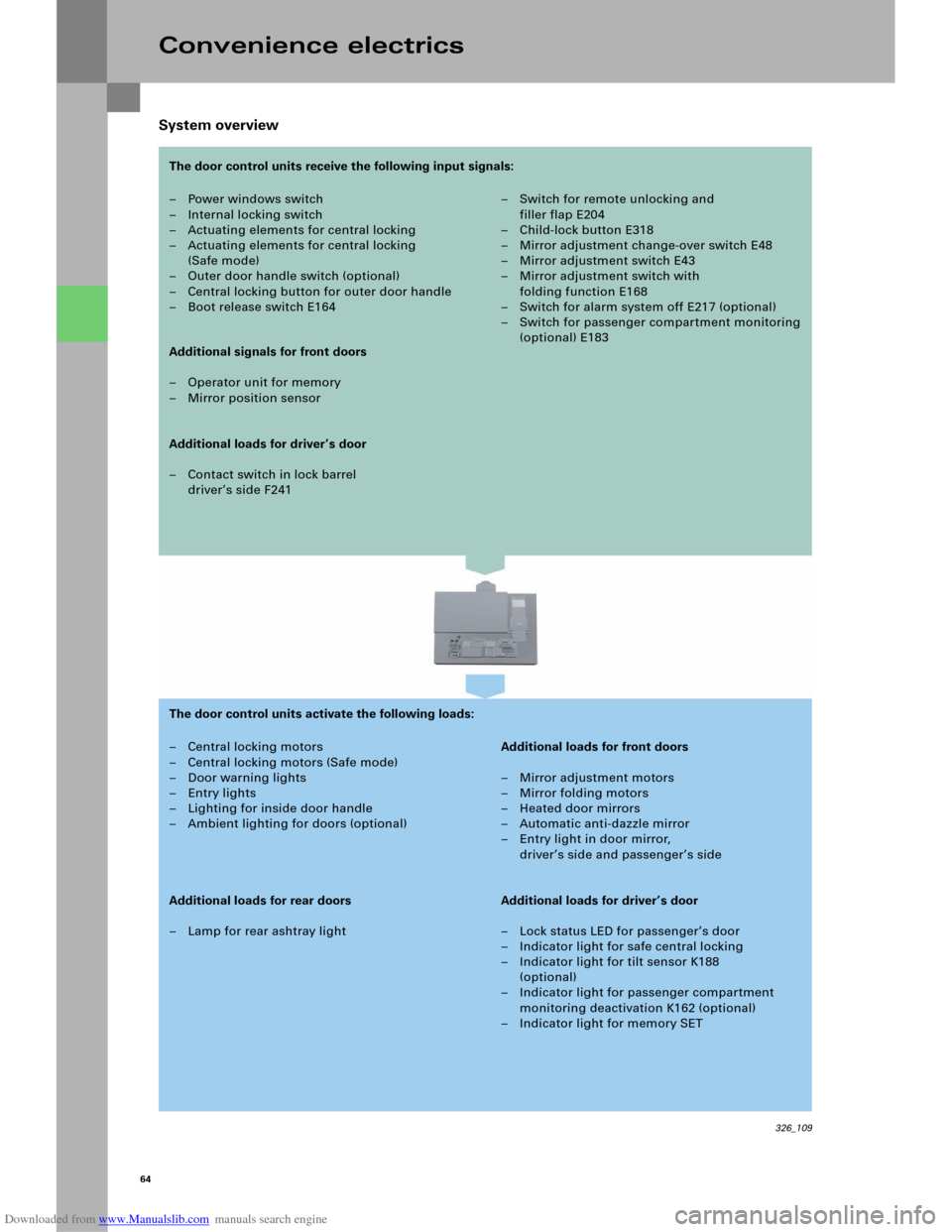
Downloaded from www.Manualslib.com manuals search engine 64
System overview
Convenience electrics
– Power windows switch
– Internal locking switch
– Actuating elements for central locking
– Actuating elements for central locking
(Safe mode)
– Outer door handle switch (optional)
– Central locking button for outer door handle
– Boot release switch E164– Switch for remote unlocking and
filler flap E204
–Child-lock button E318
– Mirror adjustment change-over switch E48
–Mirror adjustment switch E43
– Mirror adjustment switch with
folding function E168
– Switch for alarm system off E217 (optional)
– Switch for passenger compartment monitoring
(optional) E183
Additional signals for front doors
– Operator unit for memory
– Mirror position sensor
Additional loads for driver’s door
– Contact switch in lock barrel
driver’s side F241
– Central locking motors
– Central locking motors (Safe mode)
– Door warning lights
–Entry lights
– Lighting for inside door handle
– Ambient lighting for doors (optional)Additional loads for front doors
– Mirror adjustment motors
– Mirror folding motors
– Heated door mirrors
– Automatic anti-dazzle mirror
– Entry light in door mirror,
driver’s side and passenger’s side
Additional loads for rear doors
–Lamp for rear ashtray lightAdditional loads for driver’s door
– Lock status LED for passenger’s door
– Indicator light for safe central locking
– Indicator light for tilt sensor K188
(optional)
– Indicator light for passenger compartment
monitoring deactivation K162 (optional)
– Indicator light for memory SET
326_109
The door control units receive the following input signals:
The door control units activate the following loads:
Page 64 of 92
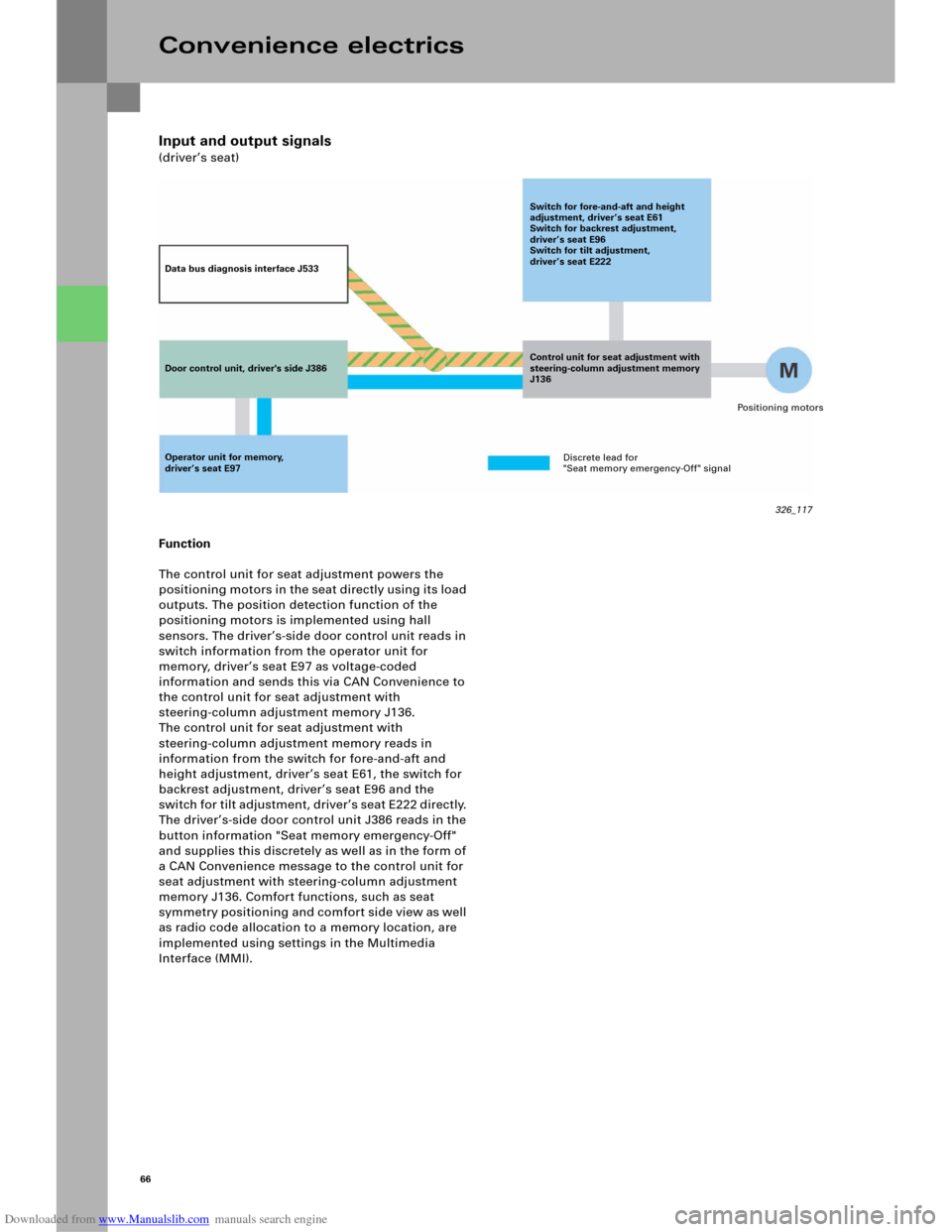
Downloaded from www.Manualslib.com manuals search engine 66
Input and output signals
(driver’s seat)
Convenience electrics
Function
The control unit for seat adjustment powers the
positioning motors in the seat directly using its load
outputs. The position detection function of the
positioning motors is implemented using hall
sensors. The driver’s-side door control unit reads in
switch information from the operator unit for
memory, driver’s seat E97 as voltage-coded
information and sends this via CAN Convenience to
the control unit for seat adjustment with
steering-column adjustment memory J136.
The control unit for seat adjustment with
steering-column adjustment memory reads in
information from the switch for fore-and-aft and
height adjustment, driver’s seat E61, the switch for
backrest adjustment, driver’s seat E96 and the
switch for tilt adjustment, driver’s seat E222 directly.
The driver’s-side door control unit J386 reads in the
button information "Seat memory emergency-Off"
and supplies this discretely as well as in the form of
a CAN Convenience message to the control unit for
seat adjustment with steering-column adjustment
memory J136. Comfort functions, such as seat
symmetry positioning and comfort side view as well
as radio code allocation to a memory location, are
implemented using settings in the Multimedia
Interface (MMI).
Data bus diagnosis interface J533
Door control unit, driver's side J386Switch for fore-and-aft and height
adjustment, driver’s seat E61
Switch for backrest adjustment,
driver’s seat E96
Switch for tilt adjustment,
driver’s seat E222
Control unit for seat adjustment with
steering-column adjustment memory
J136
Operator unit for memory,
driver’s seat E97Discrete lead for
"Seat memory emergency-Off" signalPositioning motors
326_117